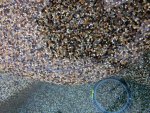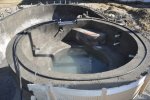- Mar 1, 2017
- 43
- Pool Size
- 25000
- Surface
- Plaster
- Chlorine
- Salt Water Generator
- SWG Type
- Pentair Intellichlor IC-40
I had a pool and spa built in April of 2011. The pool and spa shell is shotcrete with a PebbleTec plaster finish. When the pool was built, the builder specified a tri-chlor tab feeding system. After the pool was completed, he brought in his "startup" person who wired everything up and got everything running. I then hired him to maintain the pool on a weekly basis.
After one year, my conditioner levels were over 350ppm and we were having a terrible time keeping algae at bay unless chlorine levels were over 8ppm. At the recommendation of several friends who've owned pools for years, I drained the pool and had a Pentair IntelliChlor salt system installed and I've been a happy camper ever since. Conditioner levels are low but effective and chlorine hovers around 1ppm without any issues (and yes, all other levels are in check).
Fast forward five years:
My spa top step has developed a crack at the top edge about 10" long and about 1/8" wide. I called my builder and he said the crack is caused by using salt as the chlorination source. He claims that salt gets into any microscopic pore and creates a "fracking" effect, and this is why the crack has appeared. He said all bets are off when any pool uses salt.
So with that, I called an independent pool structural engineer who said that blaming salt or any chemical imbalance is "BS". He said that more then likely there is an underlying issue with the shotcrete, and that he's willing to bet that ""rebound" will be found when the plaster is removed to investigate the issue. He added that one can blame salt and/or chemical issues for plaster discoloration, eroding the surface, causing issues with coping where water has been splashed/dried and salt left on the surface, etc - but not for deep cracks like this.
I've attached an images of the crack, and one of the spa shell while it was curing.
Any help/advice would be appreciated.
- Many thanks


After one year, my conditioner levels were over 350ppm and we were having a terrible time keeping algae at bay unless chlorine levels were over 8ppm. At the recommendation of several friends who've owned pools for years, I drained the pool and had a Pentair IntelliChlor salt system installed and I've been a happy camper ever since. Conditioner levels are low but effective and chlorine hovers around 1ppm without any issues (and yes, all other levels are in check).
Fast forward five years:
My spa top step has developed a crack at the top edge about 10" long and about 1/8" wide. I called my builder and he said the crack is caused by using salt as the chlorination source. He claims that salt gets into any microscopic pore and creates a "fracking" effect, and this is why the crack has appeared. He said all bets are off when any pool uses salt.
So with that, I called an independent pool structural engineer who said that blaming salt or any chemical imbalance is "BS". He said that more then likely there is an underlying issue with the shotcrete, and that he's willing to bet that ""rebound" will be found when the plaster is removed to investigate the issue. He added that one can blame salt and/or chemical issues for plaster discoloration, eroding the surface, causing issues with coping where water has been splashed/dried and salt left on the surface, etc - but not for deep cracks like this.
I've attached an images of the crack, and one of the spa shell while it was curing.
Any help/advice would be appreciated.
- Many thanks







